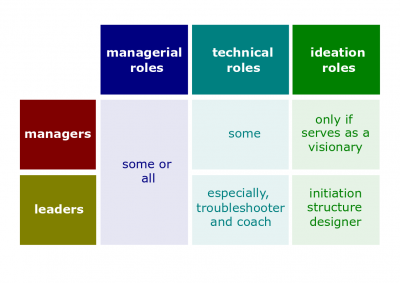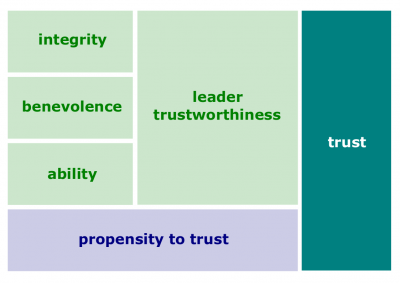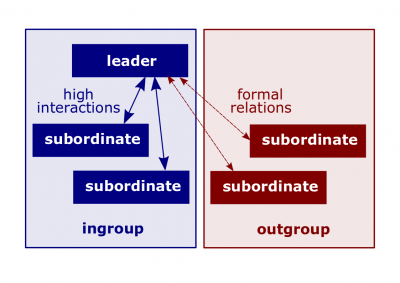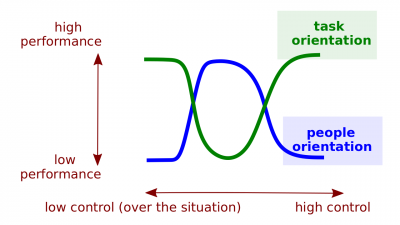Difference between revisions of "Leadership Quarter"
(→Instruments) |
|||
| Line 50: | Line 50: | ||
#*[[Legitimate power]]. The power a person receives as a result of his or her position in the formal hierarchy of an organization. | #*[[Legitimate power]]. The power a person receives as a result of his or her position in the formal hierarchy of an organization. | ||
#*[[Expert power]]. Influence based on expertise, special skills, or knowledge. | #*[[Expert power]]. Influence based on expertise, special skills, or knowledge. | ||
| − | #'''[[Leadership style]]'''. A [[leader]]'s style of providing direction, implementing plans, and motivating people. | + | #'''[[Leadership style]]'''. A [[leader]]'s style of providing direction, implementing plans, and motivating people. [[Full Range Leadership Model]] and [[managerial grid]] are some of attempts to identify and classify different [[leadership styles]] such as as exhibited by leaders in the political, business or other fields. |
#*[[Autocratic style]]. Leadership style of someone who dictates work methods, makes unilateral decisions, and limits employee participation. | #*[[Autocratic style]]. Leadership style of someone who dictates work methods, makes unilateral decisions, and limits employee participation. | ||
#*[[Democratic style]]. Leadership style of someone who involves employees in [[decision making]], delegates [[authority]], and uses feedback as an opportunity for coaching employees. | #*[[Democratic style]]. Leadership style of someone who involves employees in [[decision making]], delegates [[authority]], and uses feedback as an opportunity for coaching employees. | ||
Revision as of 17:56, 19 November 2018
Leadership Quarter (hereinafter, the Quarter) is a lecture introducing the learners to team management primarily through key topics related to leadership. The Quarter is the last of four lectures of Team Quadrivium, which is the sixth of seven modules of Septem Artes Administrativi (hereinafter, the Course). The Course is designed to introduce the learners to general concepts in business administration, management, and organizational behavior.
Contents
Outline
Workforce Arrangements Quarter is the predecessor lecture. In the enterprise planning series, the previous lecture is Relationship Management Quarter.
Concepts
- Leadership. A process of influencing a group to achieve a vision or set of goals, as well as the ability to do so.
- Authentic leadership. Leadership expressed by those who know who they are, know what they believe in, and act on those values and beliefs openly and candidly.
- Socialized charismatic leadership. A leadership concept that states that leaders convey values that are other-centered versus self-oriented and who role-model ethical conduct.
- Strategic leadership. The ability to anticipate, envision, maintain flexibility, think strategically, and work with others in the organization to initiate changes that will create a viable and valuable future for the organization.
- Visionary leadership. The ability to create and articulate a realistic, credible, and attractive vision of the future that improves upon the present situation.
- Influence direction.
- Leadership role. A specific action or behavior expected of and exhibited by a leader. Besides some or all managerial roles, leaders are often serve as coaches, troubleshooters, and, after changes, are expected to exhibit initiating structure behaviors.
- Initiating structure behavior. The extend to which a leader defines her or his role and the roles of group members in attaining goals.
- Leading. A management function that involves working with and through people to accomplish organizational goals. Leading includes motivating employees, directing others, selecting the most effective communication channels, and resolving conflicts.
- Leader credibility. The degree to which followers perceive someone as honest, competent, and able to inspire.
- Credibility. The quality of being trusted and believed in.
- Global mind set. Attributes that allow a leader to be effective in cross-cultural environments.
- Leadership orientation.
- Task orientation.
- Relationship orientation (also known as human relations orientation or people orientation).
- Leader-member relations. (1) The degree of confidence, trust, and respect subordinates have in their leader; (2) One of initial situational contingencies of the Fiedler contingency model that describes the degree of confidence, trust, and respect employees have for their leader.
- Consideration. The extent to which a leader is likely to have job relationships characterized by mutual trust, respect for subordinates' ideas, and regard for their feelings.
- Trust. A positive expectation that another will not act opportunistically. For a leader, trust is the belief in the integrity, character, and ability to lead.
- Trust propensity. How likely an employee is to trust a leader.
- Identification-based trust. Trust based on a mutual understanding of each other's intentions and appreciation of each other's wants and desires.
- Trust component. A part or element of trust.
- Integrity. (1) The quality of being honest and having strong moral principles; moral uprightness; (2) The state of being whole and undivided.
- Leader competence. The ability to lead successfully.
- Consistency. Conformity in the application of something, typically that which is necessary for the sake of logic, accuracy, or fairness.
- Loyalty. The quality of being loyal to someone or something.
- Openness. (1) Lack of restriction; accessibility; (2) Lack of secrecy or concealment; frankness.
- Leadership theory. A supposition or a system of ideas intended to explain leadership.
- Attribution theory of leadership. A leadership theory that says that leadership is merely an attribution that people make about other individuals.
- Behavioral theory of leadership. Any leadership theory that identifies behaviors that differentiate effective leaders from ineffective leaders, as well as differentiate leaders from non-leaders.
- Charismatic leadership theory. A leadership theory that states that followers make attributions of heroic and extraordinary leadership abilities when they observe certain behaviors.
- Leader-member exchange theory. The leadership theory that says leaders create ingroups and outgroups and those in the ingroup will have higher performance ratings, less turnover, and greater job satisfaction.
- Situational leadership theory. A leadership contingency theory that focuses on followers' readiness.
- Trait theory of leadership. One of theories that consider personal qualities and characteristics that differentiate leaders from nonleaders.
- Leader-participation model. A leadership theory that provides a set of rules to determine the form and amount of participative decision making in different situations.
- Power. A capacity that A has to influence the behavior of B so that B acts in accordance with A's wishes.
- Position power. Influence derived from one's formal structural position in the organization; includes power to hire, fire, discipline, promote, and give salary increases.
- Reward power. Compliance achieved based on the ability to distribute rewards that others view as valuable.
- Coercive power. (1) The power a leader has to punish or control; (2) A power base that is dependent on fear of the negative effects from failing to comply.
- Referent power. Influence based on identification with a person who has desirable resources or personal traits.
- Legitimate power. The power a person receives as a result of his or her position in the formal hierarchy of an organization.
- Expert power. Influence based on expertise, special skills, or knowledge.
- Leadership style. A leader's style of providing direction, implementing plans, and motivating people. Full Range Leadership Model and managerial grid are some of attempts to identify and classify different leadership styles such as as exhibited by leaders in the political, business or other fields.
- Autocratic style. Leadership style of someone who dictates work methods, makes unilateral decisions, and limits employee participation.
- Democratic style. Leadership style of someone who involves employees in decision making, delegates authority, and uses feedback as an opportunity for coaching employees.
- Servant leadership. A leadership style marked by going beyond the leader's own self-interest and instead focusing on opportunities to help followers grow and develop.
- Routine leadership irrelevance. The approach that a leader is not needed in routine operations.
Routine leadership irrelevance Relationship orientation Task orientation Individual Experience and/or training No effect on Substitutes for Professionalism Substitutes for Substitutes for Indifference to rewards Neutralizes Neutralizes Task Highly structured task No effect on Substitutes for Provides its own feedback No effect on Substitutes for Intrinsically satisfying Substitutes for No effect on Enterprise Explicit formalized goals No effect on Substitutes for Rigid rules and procedures No effect on Substitutes for Cohesive workgroups Substitutes for Substitutes for - Leader neutralizer. An attribute or set of attributes that make it impossible for leader behavior to make any difference to follower outcomes.
- Leader substitute. An attribute or set of attributes, such as experience and training, that can replace the need for a leader's support or ability to create structure.
- Self organization. The principle that those closest to the work best know how to do the work, so set clear goals and boundaries and let them make all tactical and implementation decisions, cf. emergence, empiricism.
- Emergence. The principle that the best designs, and the best ways of working come about over time through doing the work, rather than being defined in advance, cf. empiricism, self organization.
- Empiricism. The principle of "inspect and adapt" which allows teams or individuals to try something out and learn from the experience by conscious reflection and change, cf. emergence, self organization.
Roles
- Leader. (1) The person who leads or commands a group, organization, or country; (2) Someone who can influence others toward attaining some goal.
- Charismatic leader. An enthusiastic, self-confident leader whose personality and actions influence people to behave in certain ways.
- Transactional leader. A leader who leads primarily by using social exchanges (or transactions). A transactional leader guides or motivates his or her followers in the direction of established goals by clarifying role and task requirements.
- Transformational leader. A leader who stimulates and inspires (transforms) followers to achieve extraordinary outcomes. A transformational leader inspires his or her followers to transcend their own self-interests and who is capable of having a profound and extraordinary effect on followers.
- Authentic leader. A leader who knows who he or she is, knows what he or she believes in and values, and acts on those values and beliefs openly and candidly. Their followers would consider them to be ethical people.
- High-high leader. A leader high in both initiating structure and consideration behaviors.
- Coach.
- Troubleshooter.
Methods
- Power tactic. A way in which individuals translate power bases into specific actions.
Power tactics by influence directions Upward influence Lateral influence Downward influence - Team building. High interaction among team members to increase trust and openness.
- Team development. Developing individual and group competencies to enhance performance of a workgroup.
Instruments
- Full Range Leadership Model. A model that depicts seven managerial leadership styles on a continuum: (1) laissez-faire, (2) management by exception, (3) contingent reward leadership, (4) individualized consideration, (5) intellectual stimulation, (6) inspirational motivation, and (7) idealized influence.
- Laissez-faire style. Leadership style of someone who lets the group make decisions and complete the work in whatever way it sees fit.
- Managerial grid. A two-dimensional grid for appraising leadership styles.
- Fiedler contingency model. A model that suggests that effective group performance depends on the proper match between a leader's orientation, whether he or she is task-oriented or people-oriented, and the degree to which the situation allows the leader to control and influence. The model (1) uses a least preferred coworker questionnaire to classify leaders, (2) assumes that leaders cannot be both task-oriented or people-oriented, and (3) suggests that people orientation is the best match to the situations with moderate control, while those leaders who are task-oriented best perform in situations with high or low control.
- Least preferred coworker questionnaire. An instrument that purports to measure whether a person is task or relationship oriented. The questionnaire has initially been developed for the Fiedler contingency model.
- Path-goal model. A model that suggests that the leader's job is to assist followers in attaining their goals and to provide direction or support needed to ensure that their goals are compatible with the goals of the group or organization.
Practices
- Political slang.
Political slang versus "Effective management" label Blaming others Fixing responsibility "Kissing up" Developing working relationships Apple polishing Demonstrating loyalty Passing the buck Delegating authority Covering your rear Documenting decisions Creating conflict Encouraging change and innovation Forming coalitions Facilitating teamwork Whistle-blowing Improving efficiency Scheming Planning ahead Overachieving Competent and capable Ambitious Career minded Opportunistic Astute Cunning Practical minded Arrogant Confident Perfectionist Attentive to detail
Bookkeeping Quarter is the successor lecture. In the enterprise planning series, the next lecture is Resource Planning Quarter.





